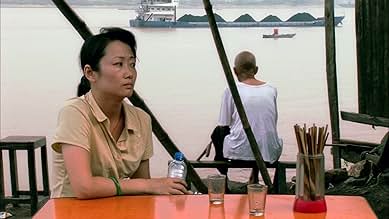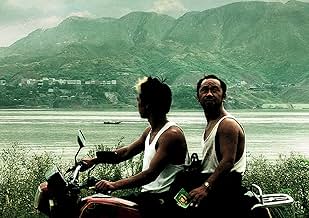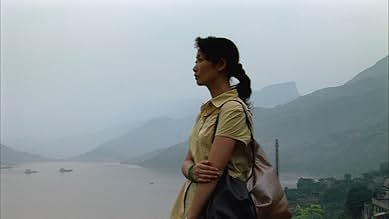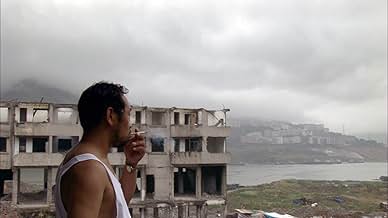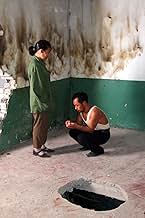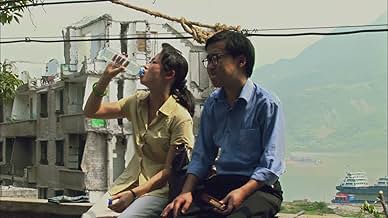NOTE IMDb
7,3/10
7,7 k
MA NOTE
Ajouter une intrigue dans votre langueA town in Fengjie county is gradually being demolished and flooded to make way for the Three Gorges Dam. A man and woman visit the town to locate their estranged spouses, and become witness ... Tout lireA town in Fengjie county is gradually being demolished and flooded to make way for the Three Gorges Dam. A man and woman visit the town to locate their estranged spouses, and become witness to the societal changes.A town in Fengjie county is gradually being demolished and flooded to make way for the Three Gorges Dam. A man and woman visit the town to locate their estranged spouses, and become witness to the societal changes.
- Réalisation
- Scénario
- Casting principal
- Récompenses
- 15 victoires et 14 nominations au total
Avis à la une
10enzino-1
Known previously as a documentary, and not as a romance, "Sanxia Haoren" ("Still Life") was the surprise and last film in Venice Festival (Italy) and not even the first one film of the young maker (he already had another movie in competition). Mr Jia shows us China just as it is nowadays. Not the power of huge works, or the beautiful scenery, just as the Dam on the Yangsi River nearby, but simple Chinese people, with simple problems, that do not know nothing such happiness (yet). It's heartbreaking, it's wonderfully filmed, it's like a superb painting. A simple masterpiece (and not only a Golden Lion). The surprise at Venice's Mostra. Catherine Deneuve, the French president of the jury of Venice, was very moved by Jia's work, the story told and the emotion of that film.
Reviewed at the North American premiere screening Tues. Sept. 12, 2006 at the Varsity 8 Theatre during the Toronto International Film Festival (TIFF).
I was lucky enough to be at TIFF screenings on Monday when it was announced that Sanxia Haoren was going to have a special one-time screening as a last minute addition to the Visions programme of TIFF 2006. I think the online tickets went fairly quickly and the theatre was packed with a considerable overflow of film writers & critics who had been unable to squeeze into the industry screening.
Sanxia Haoren has been given the title Still Life for international release, but the original Chinese title would seem to translate simply as Three Gorges Good People and it is in the vicinity of the dam's construction and the city demolitions and the people displacement entailed by it, that the film takes place. The film has a bookend plot of a miner Han Sanming (character's and actor's names are identical) who comes to the town of Fengjie to search for his estranged wife and child. The centrepiece story is that of a nurse named Shen Hong who is searching for her missing husband.
The dour faced Han Sanming is initially a cause of concern as it seems at the very start he is going to be swindled by tricksters on the river ferry but he soon shows that he can hold his own. We then think he is going to conned by a sarcastic motorcycle taxi driver who takes him to the location of his supposed house only for him to find it is now submerged under water. Things soon settle down for Han though as he finds lodging in a boarding house and work as a house demolition man on a crew with a brash young man who seems to have learned all his life lessons from the movies of Chow Yun Fat. Various humorous interludes (such as a young boy who sneaks cigarettes and roams around singing overly romantic songs which usually degenerate into an off-key screech by their end) and certain magic sequences (which I won't spoil) serve to bring comedy and wonder along the way. Several times the screen is seemingly chapter titled with the words "cigarette", "liquor", "tea" and "toffee", when these items occur during the plot, and any other meaning to this device eluded me. The journey of Shen Hong is similarly full of encounters with different characters on the way. I don't think the two stories actually intersected, but I may have been somewhat tired at this mid-way mark of TIFF as this screening went from 10:30 pm to 12:30 am.
The impression that the actors were perhaps simply playing versions of themselves was reinforced later in the week when I also caught the same director's documentary "Dong" which follows painter Liu Xiao-dong around locations at the Three Gorges Dam and it turned out that Han Sanming was actually one of the sturdy workmen that painter Liu was using for his models in a large multi-paneled painting of men. A blond-dye haired motorcycle taxi driver of Still Life makes a cameo appearance in Dong as well.
I found both of these films equally absorbing as they told stories of regular people in somewhat extreme life-changing situations and also that the 2 films complemented each other in a symbiotic way. Seeing one will enhance your appreciation of the other and vice versa. Both films are very deliberately paced but very lyrical and if you have an appreciation for slower paced film they are very rewarding. Also, if you did not have any concept of the magnitude of what is going on in the Three Gorges area, these films will give you a first hand view.
The director Jia Zhang-ke was not in attendance for the North American premiere, as he presumably was still in Venice celebrating his win of the Golden Lion for this film and 2 awards for the documentary.
I was lucky enough to be at TIFF screenings on Monday when it was announced that Sanxia Haoren was going to have a special one-time screening as a last minute addition to the Visions programme of TIFF 2006. I think the online tickets went fairly quickly and the theatre was packed with a considerable overflow of film writers & critics who had been unable to squeeze into the industry screening.
Sanxia Haoren has been given the title Still Life for international release, but the original Chinese title would seem to translate simply as Three Gorges Good People and it is in the vicinity of the dam's construction and the city demolitions and the people displacement entailed by it, that the film takes place. The film has a bookend plot of a miner Han Sanming (character's and actor's names are identical) who comes to the town of Fengjie to search for his estranged wife and child. The centrepiece story is that of a nurse named Shen Hong who is searching for her missing husband.
The dour faced Han Sanming is initially a cause of concern as it seems at the very start he is going to be swindled by tricksters on the river ferry but he soon shows that he can hold his own. We then think he is going to conned by a sarcastic motorcycle taxi driver who takes him to the location of his supposed house only for him to find it is now submerged under water. Things soon settle down for Han though as he finds lodging in a boarding house and work as a house demolition man on a crew with a brash young man who seems to have learned all his life lessons from the movies of Chow Yun Fat. Various humorous interludes (such as a young boy who sneaks cigarettes and roams around singing overly romantic songs which usually degenerate into an off-key screech by their end) and certain magic sequences (which I won't spoil) serve to bring comedy and wonder along the way. Several times the screen is seemingly chapter titled with the words "cigarette", "liquor", "tea" and "toffee", when these items occur during the plot, and any other meaning to this device eluded me. The journey of Shen Hong is similarly full of encounters with different characters on the way. I don't think the two stories actually intersected, but I may have been somewhat tired at this mid-way mark of TIFF as this screening went from 10:30 pm to 12:30 am.
The impression that the actors were perhaps simply playing versions of themselves was reinforced later in the week when I also caught the same director's documentary "Dong" which follows painter Liu Xiao-dong around locations at the Three Gorges Dam and it turned out that Han Sanming was actually one of the sturdy workmen that painter Liu was using for his models in a large multi-paneled painting of men. A blond-dye haired motorcycle taxi driver of Still Life makes a cameo appearance in Dong as well.
I found both of these films equally absorbing as they told stories of regular people in somewhat extreme life-changing situations and also that the 2 films complemented each other in a symbiotic way. Seeing one will enhance your appreciation of the other and vice versa. Both films are very deliberately paced but very lyrical and if you have an appreciation for slower paced film they are very rewarding. Also, if you did not have any concept of the magnitude of what is going on in the Three Gorges area, these films will give you a first hand view.
The director Jia Zhang-ke was not in attendance for the North American premiere, as he presumably was still in Venice celebrating his win of the Golden Lion for this film and 2 awards for the documentary.
I've seen lots of presentations by businesspeople and academics about Chinese industry, development, social problems, politics, progress, environmental disasters, etc. etc. I've never seen anything like this. It's China on the ground - actually a town about to be submerged by the Three Gorgest Dam project. The title translation of "Three Gorges Good People" is right - these are ordinary folks who endure, persist, help each other out, etc. in a mixed landscape of natural beauty, building, poverty, and destruction that has to be seen to be understood. The story of the dam shapes everybody's life without actually determining or washing them out. Definitely try to see this if you have any interest at all in China today.
Ancient towns have been submerged along the Yangtse River in China as part of the Three Gorges Dam project. Jia Zhang-Ke has created a contemplative and compassionate human drama set in the region, depicting two separate protagonists attempting to locate missing ones who lived in areas now underwater.
I'm not a great fan of high definition digital video photography, but this sublime film takes advantage of the benefits of the technology while avoiding most of the pitfalls. I was seriously sleep-deprived while watching the film and never got close to nodding off, even though there are very long takes where little seems to happen. Yet in takes, there are many passing details, the beautiful movements of camera taking in rich and authentic details of people, situations, implements, household paraphernalia and gorgeous sweeping vistas. The latter appeared to be enhanced using filters, which seemed to compensate for the loss of aesthetics that comes from not shooting on 35mm film. This film was visually beautiful, though that really only served what was an extremely well-made film.
As a lover of world cinema, I found the attention to detail fascinating. The director seemed to be sharing the idiosyncrasies of the local culture, customs and demeanour with a real sense of compassion and humanitarianism. I found it poetic, uplifting and moving. Paraphrasing Melbourne International Film Festival executive director Richard Moore's in introduction by quoting the director (who was in attendance as a guest of the festival): "I originally wanted to make films that would change the world... I now realise this is not possible, and I just wish to make films that make people sigh." It worked on me.
I'm not a great fan of high definition digital video photography, but this sublime film takes advantage of the benefits of the technology while avoiding most of the pitfalls. I was seriously sleep-deprived while watching the film and never got close to nodding off, even though there are very long takes where little seems to happen. Yet in takes, there are many passing details, the beautiful movements of camera taking in rich and authentic details of people, situations, implements, household paraphernalia and gorgeous sweeping vistas. The latter appeared to be enhanced using filters, which seemed to compensate for the loss of aesthetics that comes from not shooting on 35mm film. This film was visually beautiful, though that really only served what was an extremely well-made film.
As a lover of world cinema, I found the attention to detail fascinating. The director seemed to be sharing the idiosyncrasies of the local culture, customs and demeanour with a real sense of compassion and humanitarianism. I found it poetic, uplifting and moving. Paraphrasing Melbourne International Film Festival executive director Richard Moore's in introduction by quoting the director (who was in attendance as a guest of the festival): "I originally wanted to make films that would change the world... I now realise this is not possible, and I just wish to make films that make people sigh." It worked on me.
This week China announced that about 300,000 more people than planned will be relocated as a result of the construction of the Three Gorges Dam on the Yangtze River, bringing the total displaced to more than 1.4 million. The $22.5-billion US dam, a mega-project five times the size of the Hoover Dam, which has been heavily criticized by environmental and human rights groups, was begun in 1993 but will not go into full operation until 2008. The project's effect on ordinary Chinese is the focus of Jia Zhangke's latest film, Still Life, the surprise winner of the Golden Lion Award at this year's Venice Film Festival.
Set in the village of Fengjie, since submerged in water to make way for the dam, Jia's slow-paced, class-conscious effort dramatizes the life of villagers who have been forced from their homes, had their traditional way of life destroyed, and sent to live in cities against their will, often having to resort to begging and garbage collecting, or even prostitution to stay alive. The film, along with its companion documentary Dong, tells overlapping stories of the emotional trauma of local people caught in the dislocation at Fengjie while a new village is being built.
In the first sequence, Han Sanming, a middle-aged coal miner from Jia's home Shanxi province, arrives on a ferry to look for his ex-wife, Missy after sixteen years of estrangement. All he has to rely on is an address given to him many years ago, completely unaware of the demolition and flooding in the area. Avoiding local swindlers, he tracks down Missy's uncle who tells him that his former wife is now in Yichang with his teenage daughter. Staying on to work in the demolition projects, Han engages in conversations with other workers who complain of the low wages they are receiving (60 to 70 Yuan a day) and want to return to Shanxi province with Han where they can earn 200 Yuan a day working in the dangerous coal mines.
In the second story, Shen Hong (Zhao Tao), a nurse arrives from Shanxi as well and is also searching for a missing person, her husband Guo Bin, who left the family two years ago. She is aided in her search by archaeologist Wang Dongming but it is uncertain what course of action Shen has in mind when she reunites with her husband. The film, however, is not about the story line but about the landscape and the atmosphere, playfully charged by the CG appearance of a UFO and a spaceship that takes off in the middle of the rubble.
In Still Life, Jia demonstrates to the world how one of China's most gorgeous areas, one that brings in 1.3 million tourists a year, has become a scene of squalor. Jia says: "We all know there is major change going on in China and I wanted to get more people to know what's happening. I will continue to make films along these lines and explore the problems of the weaker social classes." If Jia's future projects contain the unmatched cinematography, compelling story, and characters whose lives touch us as Still Life, we have much to look forward to.
Set in the village of Fengjie, since submerged in water to make way for the dam, Jia's slow-paced, class-conscious effort dramatizes the life of villagers who have been forced from their homes, had their traditional way of life destroyed, and sent to live in cities against their will, often having to resort to begging and garbage collecting, or even prostitution to stay alive. The film, along with its companion documentary Dong, tells overlapping stories of the emotional trauma of local people caught in the dislocation at Fengjie while a new village is being built.
In the first sequence, Han Sanming, a middle-aged coal miner from Jia's home Shanxi province, arrives on a ferry to look for his ex-wife, Missy after sixteen years of estrangement. All he has to rely on is an address given to him many years ago, completely unaware of the demolition and flooding in the area. Avoiding local swindlers, he tracks down Missy's uncle who tells him that his former wife is now in Yichang with his teenage daughter. Staying on to work in the demolition projects, Han engages in conversations with other workers who complain of the low wages they are receiving (60 to 70 Yuan a day) and want to return to Shanxi province with Han where they can earn 200 Yuan a day working in the dangerous coal mines.
In the second story, Shen Hong (Zhao Tao), a nurse arrives from Shanxi as well and is also searching for a missing person, her husband Guo Bin, who left the family two years ago. She is aided in her search by archaeologist Wang Dongming but it is uncertain what course of action Shen has in mind when she reunites with her husband. The film, however, is not about the story line but about the landscape and the atmosphere, playfully charged by the CG appearance of a UFO and a spaceship that takes off in the middle of the rubble.
In Still Life, Jia demonstrates to the world how one of China's most gorgeous areas, one that brings in 1.3 million tourists a year, has become a scene of squalor. Jia says: "We all know there is major change going on in China and I wanted to get more people to know what's happening. I will continue to make films along these lines and explore the problems of the weaker social classes." If Jia's future projects contain the unmatched cinematography, compelling story, and characters whose lives touch us as Still Life, we have much to look forward to.
Le saviez-vous
- AnecdotesRanked second in French film magazine Cahiers du cinéma's top 10 list of the best pictures of 2007, tied with Inland Empire (2006) and Boulevard de la mort (2007).
- ConnexionsFeatures Le syndicat du crime (1986)
Meilleurs choix
Connectez-vous pour évaluer et suivre la liste de favoris afin de recevoir des recommandations personnalisées
- How long is Still Life?Alimenté par Alexa
Détails
Box-office
- Budget
- 10 000 000 CNY (estimé)
- Montant brut aux États-Unis et au Canada
- 76 983 $US
- Week-end de sortie aux États-Unis et au Canada
- 12 744 $US
- 20 janv. 2008
- Montant brut mondial
- 2 504 465 $US
- Durée1 heure 51 minutes
- Couleur
- Mixage
- Rapport de forme
- 1.78 : 1
Contribuer à cette page
Suggérer une modification ou ajouter du contenu manquant




